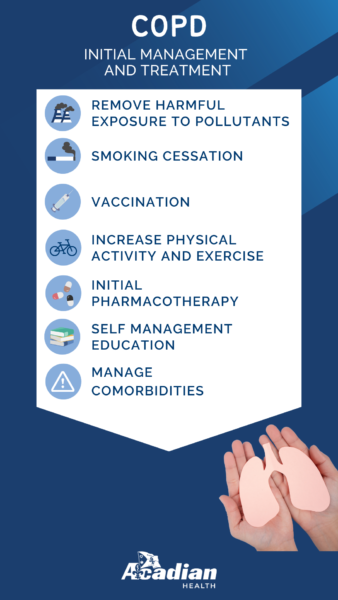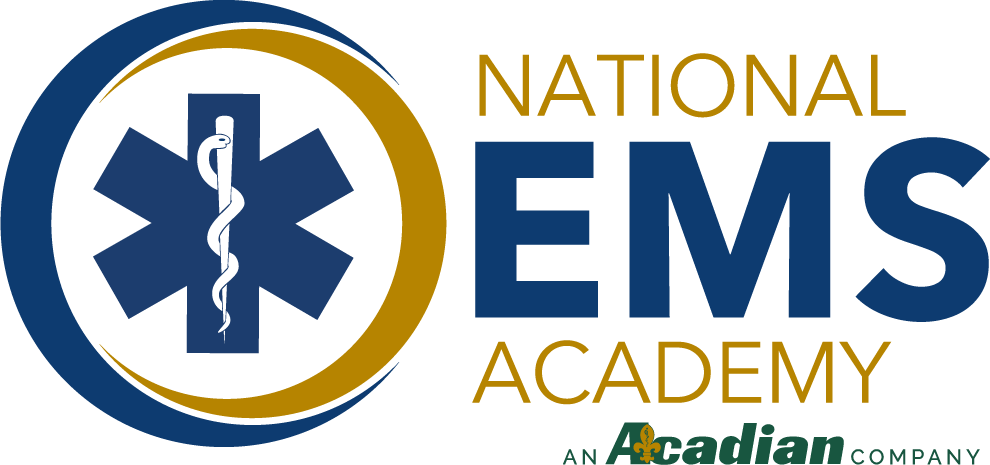By Aaron Webb, Acadian Physician Assistant
Chronic obstructive pulmonary disease (COPD), as defined by Global Initiative for Chronic Obstructive Lung Disease (GOLD), is a common, preventable and treatable disease that is characterized by persistent respiratory symptoms and air flow limitation that is due to airway and/or alveolar abnormalities usually caused by significant exposure to noxious particles or gasses and influenced by host factors including abnormal lung development. In other words, this is a disease that negatively affects the way you breath because of problems with air moving in and out of your lungs. It is usually caused by environmental exposures such as smoking or air pollution but may also be caused by problems with your lungs that you may have no control over.
The symptoms of COPD include dyspnea, or difficulty breathing, chronic cough or sputum production, or recurrent lower respiratory tract infections such as pneumonia or bronchitis. Other more subtle symptoms may include difficulty sleeping or even loss of energy.
There are many causes of COPD, some that are well known, and some that are less known. The most commonly cited risk factor for COPD is tobacco smoke. Cigarette smokers particularly have a high prevalence of respiratory symptoms and lung function abnormalities. Smoking cigars, pipes, and marijuana are also risk factors, including secondhand smoke. Other causes of COPD include indoor air pollution such as burning of wood used for cooking and heating in poorly vented homes, outdoor air pollution, and exposure to dusts, chemicals, and fumes in occupational settings. Non environmental risk factors include genetic disorders such as alpha-1 antitrypsin deficiency, and poor lung development in utero. Chronic bronchitis or a history of severe childhood respiratory infections also seem to be associated with increased rates of COPD.
If you experience any of the symptoms above and/or have a history of exposure to some of these risk factors, the diagnosis of COPD should be considered. Testing for COPD usually includes spirometry, and other pulmonary function tests. These tests are noninvasive and not painful. They simply measure air flow to identify abnormalities.

- Smoking cessation
- Removal of/from harmful exposures to pollutants
- Vaccination
- Increasing physical activity and exercise
- Initial pharmacotherapy
- Self management education
- Managing comorbidities
Because cigarette smoking is the most commonly known cause for COPD, smoking cessation is the first strategy in managing and preventing further progression of COPD. Although quitting smoking is difficult, there are effective treatments available, and healthcare providers should discuss these in detail.
Vaccination for respiratory pathogens can decrease the frequency and severity of symptoms and exacerbations of COPD, by preventing common illnesses that can make the disease worse. Some of these pathogens include pneumococcal pneumonia, influenza, and COVID 19.
Improving physical activity can lead to improved symptoms of COPD. It may seem counterintuitive because exercise can worsen difficulty breathing, so it is important to discuss exercise regimens with your healthcare provider before initiation. Improving muscle strength and cardiovascular fitness can improve how your body uses oxygen, and potentially decrease your level of difficulty breathing in the long run.
Pharmacotherapy, or medications, are an important part of managing COPD. There are many types of medications, and medication regimens should be individualized and guided by the symptoms, among other important factors. Medications are used to improve symptoms and decrease the frequency and severity of exacerbations. There are no medications available that can reverse lung damage, or cure COPD.
Bronchodilators are the most common medications used to treat COPD. These medications relax smooth muscles in the airways which increases the size of the airways and reduces air flow resistance. There are different classes of bronchodilators, including beta-2 agonists and muscarinic antagonists. They both have similar effects on the airways, but use different physiological pathways. There are short acting and long acting bronchodilators. And there are combinations of these bronchodilators. Short acting bronchodilators are often used regularly or as-needed and can improve symptoms. Long acting bronchodilators significantly improve lung function, dyspnea, health status, and reduce exacerbation frequencies. These medications are inhaled via a handheld pump or a nebulizer machine.
In addition to bronchodilators, another medication commonly used to control or manage COPD include inhaled corticosteroids. Inhaled corticosteroids combined with long acting bronchodilators is a more effective use of these medications when compared to using each of them alone. Oral steroids can be effective for exacerbations in hospitalized emergency department patients. Caution must be used as there is strong evidence for an increased risk of pneumonia with regular treatment of corticosteroids.
PDE4 inhibitors, such as roflumilast, are a relatively new class of medications that can treat severe COPD and chronic bronchitis.
Long-term use of antibiotics like azithromycin can be used to reduce exacerbations. Unfortunately, this has also been associated with an increased incidence of bacterial resistance and hearing impairments.
Management of exacerbations should begin with short acting inhaled beta agonists. The addition of systemic corticosteroids can also be effective, but the duration should not exceed one week. Antibiotics can also shorten time to recovery and reduce the risk of early relapse. For patients in the emergency department or hospital, noninvasive mechanical ventilation is common if acute respiratory failure is a concern.
COPD self management and education is an important part of managing this disease. You must understand the risk factors associated with this disease and how to manage them. You must know how to use your medications and inhalers properly in order to make them most effective. You must understand how to recognize your symptoms, as well as the subtle changes in symptoms that may lead to an exacerbation. And finally, you must have a written action plan which gives you specific guidance on how to manage symptoms when they seem to be worsening.
Once management for COPD has begun, a regular review with your healthcare provider is imperative to assess the effectiveness of the chosen therapy. Therapies may become insufficient as lung function may worsen over time even with treatment, and may need to be adjusted based on your response to those therapies. These re-evaluations should include an annual spirometry test, a review of your inhaler usage techniques and your adherence to the medication regimen. If the response to the initial therapies is appropriate, you may maintain this course of treatment.
Source: Global Initiative for Chronic Obstructive Lung Disease – GOLD
A Guide for Health Care Professionals, 2021 Report














